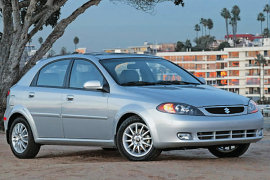SUZUKI Reno Models/Series Timeline, Specifications & Photos
First production year: 2004
Engines: Gasoline
Body style: Hatchback
A badge-engineered product, the Reno was actually a Daewoo Lacetti, but its presence on the market was a marketing strategy meant mostly to help the struggling Korean automaker.
After Daewoo left the American market due to slow sales, it found a way to sell its products in the U.S. with some help from Suzuki, which already had a strong presence. Thus, the Korean vehicles were re-badged with the Japanese brand and renamed accordingly as Reno instead of Lacetti for the hatchback version. At the same time, the Lacetti sedan was rebranded as Suzuki Forenza in the U.S.
These cars were humble options for those who needed a no-nonsense vehicle to get them from A to B. With an exterior look that still resembled the bio-design era, the Reno featured organic-looking headlights and a grille that sported a small S-badge from Suzuki. In addition, the automaker placed an apron on the lower bumper with a slatted grille flanked by fog lamps. The five-door hatchback sported raked-forward C-pillars. In addition, the tailgate was adorned by a roof spoiler mounted on the upper side.
Inside, the Reno was surprisingly well-equipped for its class. All versions featured air conditioning and an eight-speaker, MP3-capable CD-player audio system. The car featured bucket seats at the front and the 60/40 split-folding bench in the rear that expanded the 8.8 cu-ft (250 liters) trunk up to 36.6 cu-ft (1,036 liters). Moreover, the automaker offered an option for a leather-wrapped interior, which was unusual for Reno's segment.
Under the hood, the Reno received the 2.0-liter D-Tec engine made by General Motors that offered 126 hp (128 PS). Base models were fitted with a five-speed gearbox, while the top trim level received a four-speed automatic.
